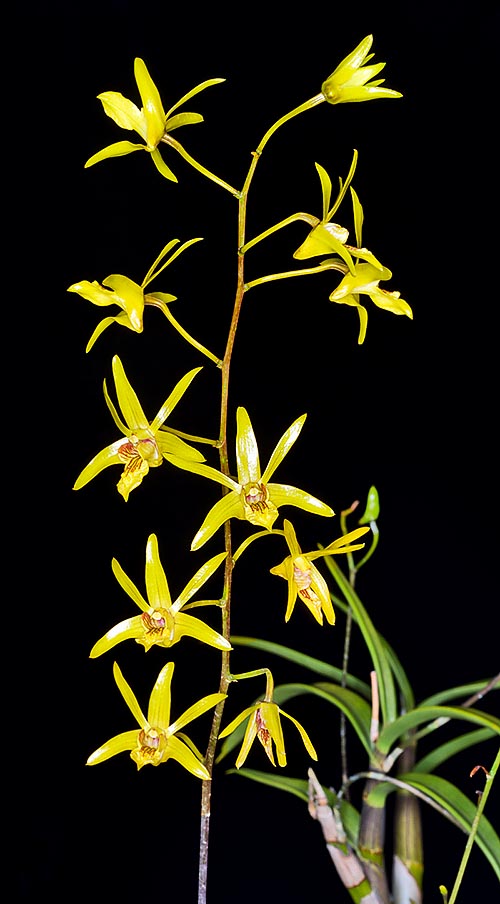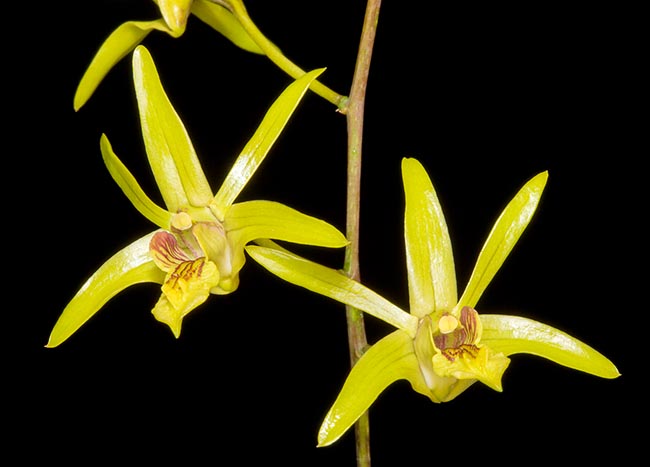Family : Orchidaceae

Text © Pietro Puccio

English translation by Mario Beltramini

Dendrobium capra is a slow growing Java epiphyte © Giuseppe Mazza
The name of the genus is the combination of the Greek substantives “δένδρον” (dendron) = tree and “βίος” (bios) = life, with reference to the numerous species of the genus living on the trees; the name of the species is the Latin substantive “capra” = goat, with reference to the shape of the petals.
Common names: anggrek larat hijau (Indonesian).
The Dendrobium capra J.J.Sm. (1910) is a slow growing epiphytic species with cylindrical, 10-45 cm long, pseudobulbs, thinned at the apex and at the base, provided in the upper half of 4-7 linear-lanceolate leaves, 7-15 cm long and 0,7-2,5 cm broad, rigid, fleshy, of glossy green colour above and opaque below.
Racemose inflorescences from the upper nodes, on a 5-13 cm long peduncle, erect or arcuate, 5-15 cm long, carrying numerous flowers of about 3 cm of diameter with glossy greenish yellow sepals and petals with slight brown venations; the blooming takes place in autumn-early winter with long lasting, more than one month, flowers.
Linear-lanceolate sepals, 1,8 cm long and about 0,6 cm broad in the median part; the lateral sepals, merged at the base of the column, form a sort of conical spur (mentum), about 0,8 cm long.
Almost erect petals, 2,2 cm long and 0,3 cm broad, linear-spatulate, retroflexed, and trilobed labellum, about 2 cm long and 1 cm broad, of light yellow colour with erect lateral lobes with violaceous striations and oblong central lobe with pointed apex run by three waved brown violaceous lamellae.
It reproduces by seed, in vitro, and division, to be done at the time of the vegetative restart, with each section provided with at least 3-4 pseudobulbs.
Fairly rare species in cultivation, requires high luminosity, also direct sun in winter during the resting period, which corresponds to the fall of the leaves of the host trees, medium-high temperatures in summer, 25-33 °C, averagely lower values in winter with lowest night ones not under the 15 °C, and high humidity, 70-80%, during the vegetative period, lower, 40-60%, in winter in correspondence with the dry season; fundamental in all seasons is a constant ventilation.
The waterings must be regular and abundant from summer to autumn, but letting to dry up before giving water again, then practically stopped in winter for two months about until the vegetative restart.

Rare in cultivation, has 5-15 cm inflorescences with flowers of 3 cm of diameter © Giuseppe Mazza
It can be mounted on bark, trunks, rafts of cork or of arborescent ferns roots, or cultivated in little deep pots or baskets with very draining and aerated compost, in order to allow the roots to quickly dry up after each watering, which may be formed by medium sliced fragments of bark and of charcoal with possible addition of inerts to improve the drainage; the repottings are to be done, when necessary, by the vegetative restart.
The species is reported in the appendix II of the CITES (species whose trade s internationally ruled).
Synonyms: Cepobaculum capra (J.J.Sm.) M.A.Clem. & D.L.Jones (2002).
→ For general notions about ORCHIDACEAE please click here.
